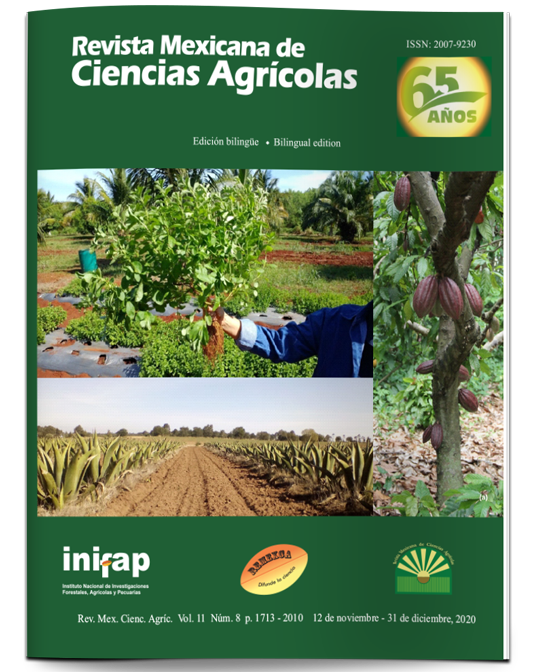The market for cape gooseberry in Mexico
DOI:
https://doi.org/10.29312/remexca.v11i8.2228Keywords:
demand, cape gooseberry, production costs, supplyAbstract
The cape gooseberry (Physalis peruviana L.) is a crop adaptable to adverse climates and prolonged production of fruits with high economic potential. In Mexico, cape gooseberry is not yet cultivated for commercial purposes, due to ignorance of its consumption and profitability. The objective was to analyze the profitability of the cultivation of cape gooseberry in greenhouse and hydroponics and its consumption in Mexico City, to know its commercial potential. Cape gooseberry plants were grown in a greenhouse measuring 10 x 30 m, the inputs and activities of the production and harvesting process were recorded in an Excel spreadsheet (2010), quantified and extrapolated to 1 ha. The production costs and the profitability of the crop were determined based on the internal rate of return (IRR), the net present value (NPV) and the benefit/cost ratio (B/C). The breakeven point in sales was estimated with the total costs and the initial investment. Demand was estimated based on information from 150 surveys conducted in the named markets. El 100 and Medellin, in Mexico City. Tasting tests were carried out on the respondents, considering the taste, smell and color of commercially ripe fruits. The estimated yield was 52.65 Mg ha-1 of fresh fruit with calyx, with an investment of $3 664 551 at a sale price of 30.00 $ kg-1, with NPV of $633 071, IRR of 17.24%, and B/C ratio of 1.1. The demand was determined by the price of the fruit, the income and the level of studies of the respondents. Most of that surveyed showed willingness to buy this fruit and recommended its consumption.
Downloads
Published
How to Cite
Issue
Section
License
Copyright (c) 2020 Revista Mexicana de Ciencias Agrícolas

This work is licensed under a Creative Commons Attribution-NonCommercial 4.0 International License.
The authors who publish in Revista Mexicana de Ciencias Agrícolas accept the following conditions:
In accordance with copyright laws, Revista Mexicana de Ciencias Agrícolas recognizes and respects the authors’ moral right and ownership of property rights which will be transferred to the journal for dissemination in open access. Invariably, all the authors have to sign a letter of transfer of property rights and of originality of the article to Instituto Nacional de Investigaciones Forestales, Agrícolas y Pecuarias (INIFAP) [National Institute of Forestry, Agricultural and Livestock Research]. The author(s) must pay a fee for the reception of articles before proceeding to editorial review.
All the texts published by Revista Mexicana de Ciencias Agrícolas —with no exception— are distributed under a Creative Commons License Attribution-NonCommercial 4.0 International (CC BY-NC 4.0), which allows third parties to use the publication as long as the work’s authorship and its first publication in this journal are mentioned.
The author(s) can enter into independent and additional contractual agreements for the nonexclusive distribution of the version of the article published in Revista Mexicana de Ciencias Agrícolas (for example include it into an institutional repository or publish it in a book) as long as it is clearly and explicitly indicated that the work was published for the first time in Revista Mexicana de Ciencias Agrícolas.
For all the above, the authors shall send the Letter-transfer of Property Rights for the first publication duly filled in and signed by the author(s). This form must be sent as a PDF file to: revista_atm@yahoo.com.mx; cienciasagricola@inifap.gob.mx; remexca2017@gmail.
This work is licensed under a Creative Commons Attribution-Noncommercial 4.0 International license.



